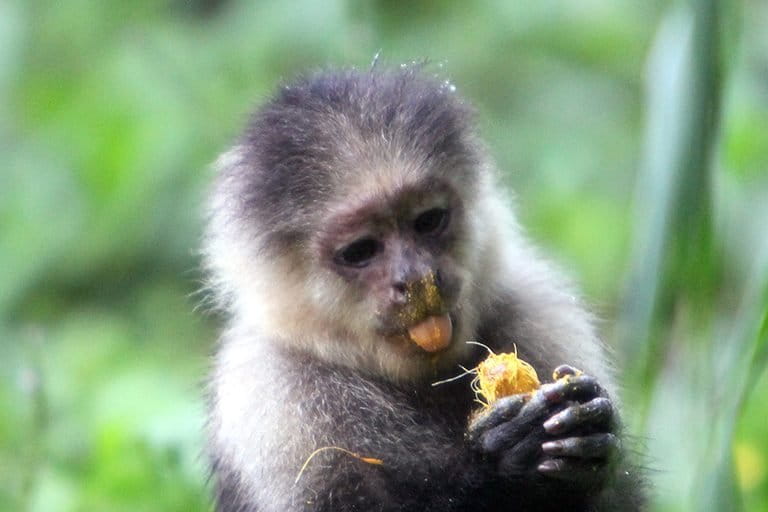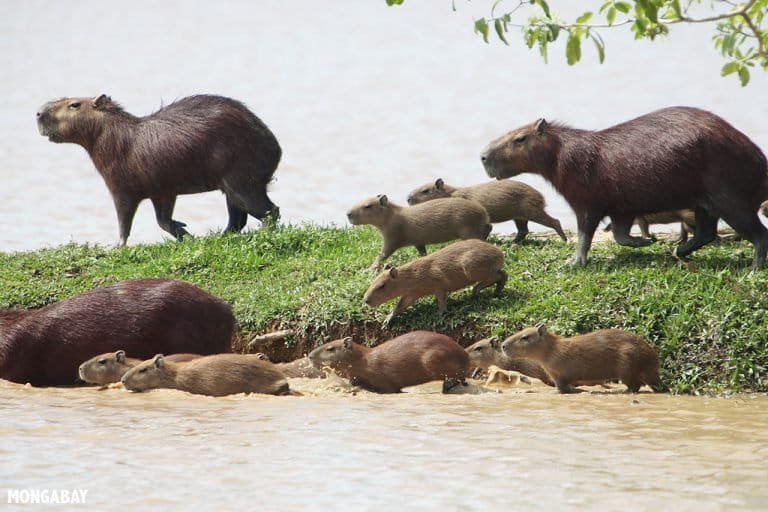- Having a diverse mix of mammals may play a more pivotal role than expected in the carbon cycle of tropical forests, by feeding microbes that lock the carbon from food scraps in the soil.
- Hundreds of indigenous research technicians collected data for this study across an area roughly the size of Costa Rica.
- Conserving mammal species will become increasingly important in efforts to protect the health of rainforest ecosystems, researchers suggest.
Amazonian rainforests bustle with activity: Monkeys snag fruit from branches in the canopy; peccaries root around in the topsoil for grubs, worms and plants; a jaguar feasts on the carcass of freshly hunted tapir. These animals have something new in common, a study now suggests: they form an important link in their ecosystem’s carbon cycle.
Hungry mammals leave carbon-rich carcasses, food scraps and feces on the forest floor. These byproducts, along with plant material, contain nutrients that soak into the soil. Microbes that thrive in this nutrient-rich soil collect and store carbon instead of releasing it to the atmosphere as carbon dioxide.

The study’s authors propose that the diversity of mammals in tropical rainforest ecosystems contributes to an unexpectedly large amount of carbon storage in soils. Previously, researchers had largely only documented how the number of mammals in a forest affects the carbon cycle.
Ecologist and team leader José Fragoso, formerly of Stanford University and now with the California Academy of Sciences in San Francisco, recalled the moment he and his colleagues knew the project was important: “We realized, ‘Wow, this is really going to change things, and it has added something new to our understanding of ecosystems.’” The study was published recently in the journal Nature Ecology and Evolution.
The analysis relied on 340 indigenous research technicians from the Makushi, Wapishana and Waiwai nations, who roamed the rainforests of Brazil and Guyana to gather more than a million data points. Working through sweltering heat and traversing rough terrain, the technicians documented the number of animal and plant species they saw along 215 separate, defined paths, each one 4 kilometers (2.5 miles) long. The technicians also recorded any animal activities they witnessed, and collected vials of soil along the trails.
The scope was ambitious. Within three years, “we sampled an area the size of Costa Rica,” said Fragoso — about 48,000 square kilometers (18,500 square miles).

Areas that were rich in mammal biodiversity had higher levels of carbon in the soils, according to the study. The researchers put forward this explanation: a greater variety of animals creates more opportunities for them to eat one another and leave behind carbon-rich fruit, seeds and animal scraps. When the team analyzed soil samples, they found that soils rich in carbon produced by this food waste had higher levels of microbe diversity. A diverse and healthy community of soil microbes to break down these scraps is an important part of trapping carbon in the soil instead of releasing it in the atmosphere.
Bradley Cardinale, director of the Cooperative Institute for Great Lakes Research at the University of Michigan, is critical of the claim. Because the analysis doesn’t factor in variables like soil temperature, moisture levels or the densities of microbes, he argues that it doesn’t accurately show a clear link between numbers of mammal species and levels of carbon in the soil.
“I don’t think there is any doubt that mammal diversity is somehow correlated with carbon in the soil,” Cardinale told Mongabay. “But they can’t demonstrate if this is actually caused by the mammals.”

In response, Fragoso said, “Each [research] group will have different perspectives of the importance and relevance” of different contributors to the carbon cycle. A team that studies plants, for instance, will focus on the role of trees in this cycle.
Amy Dunham, associate professor of ecology and evolutionary biology at Rice University in Houston, Texas, commended the study’s geographic breadth and its novel focus on how mammals distribute carbon both above and below ground.
The forest cycle is complex, and Fragoso said there’s more work to do. Next, the team hopes to study the impacts of birds, amphibians, reptiles and fish on the carbon cycle, as well as individual types of mammals. This work, Fragoso hopes, will help reinforce more holistic conservation efforts in areas of high biodiversity, including increased protections for species like jaguars, tapirs and other major Amazonian mammals.

CITATION
- Sobral, M., Silvius, M.K., Overman, H., Oliviera, B.F.L., Raab, K.T., Fragoso, V.M.J. (2017) Mammal diversity influences the carbon cycle through trophic interactions in the Amazon. Nature Ecology & Evolution 1: 1670–1676. doi:10.1038/s41559-017-0334-0
Jennifer Leman (@jlorileman) is a graduate student in the Science Communication Program at the University of California, Santa Cruz. Other Mongabay stories produced by UCSC students can be found here.